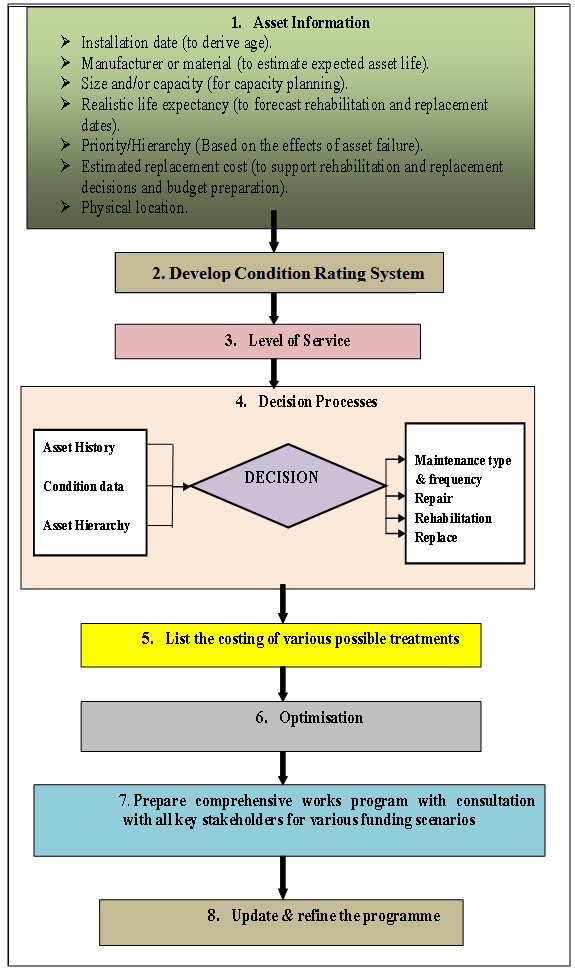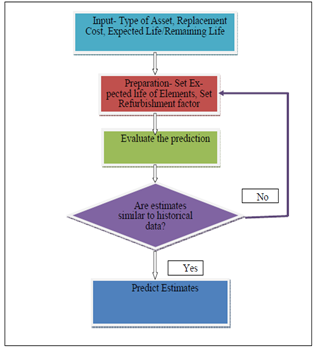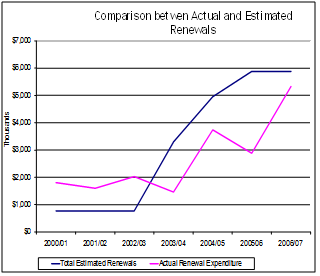-
Paper Information
- Paper Submission
-
Journal Information
- About This Journal
- Editorial Board
- Current Issue
- Archive
- Author Guidelines
- Contact Us
International Journal of Construction Engineering and Management
p-ISSN: 2326-1080 e-ISSN: 2326-1102
2012; 1(3): 14-19
doi:10.5923/j.ijcem.20120103.01
Why Simplified Asset Management is Vital for Organizational Growth
Dhirendra Kumar1, Indubhushan Patnaikuni2
1Asset Planning, Moreland City Council, Coburg, 3058, Australia
2School of Civil, Environmental. and Chemical Engineering, RMIT University, Melbourne, 3000, Australia
Correspondence to: Dhirendra Kumar, Asset Planning, Moreland City Council, Coburg, 3058, Australia.
| Email: |  |
Copyright © 2012 Scientific & Academic Publishing. All Rights Reserved.
In any organisation, asset management (AM) is vital in achieving a greater financial sustainability. The basic process of asset management involves curbing operating costs, minimising the asset maintenance, and effective management of capital. The employees also need to recognise the importance of asset management, and have the knowledge on a variety of optimisation techniques. AM best practices include a broad range of activities, but the key aspects are: Asset Planning, Setting Service Levels, Managing Risk to drive asset related decisions, Minimising Life Cycle Costs, and Managing Asset Related Knowledge. It is also about balancing Service Levels with Cost, and is extremely important to involve people throughout the organisation in the AM process instead of making it simply a staff function. It requires the right organisational arrangements to sustain gains achieved as the program evolves. Due to advancement of information technology, organisations have started using sophisticated softwares without understanding its calibrations and detailed processes involved. Using software is good but it should be limited and it should be simple to use. Asset Management cannot be performed without valuable input from experienced operations staff. No software can give us a perfect solution; in fact good quality field data is the most important information which needs to be incorporated in any asset management model/plan. The asset management team and field staff should work together in refining the asset management model and they should understand the implications of each input variable. Hence there is a great need to define a simple process in order to get an effective asset management model which can be used by all asset management practitioners. The objective of this study is to formulate a strategy which can assist us to simplify the asset management process so that whole organisation can use it in order to get maximum benefits.
Keywords: Asset Management, Service Life, Life Cycle, Buildings
Cite this paper: Dhirendra Kumar, Indubhushan Patnaikuni, Why Simplified Asset Management is Vital for Organizational Growth, International Journal of Construction Engineering and Management , Vol. 1 No. 3, 2012, pp. 14-19. doi: 10.5923/j.ijcem.20120103.01.
Article Outline
1. Introduction
- The need for effective and efficient asset management has given way to a range of asset management solutions. The assets of an organization all play significant roles in the achievement of corporate goals, and therefore must be utilized and managed optimally. The need for such tools is more significant when resources are limited. Costly asset management solutions are ending up on the cutting room floor. Too often, Managers are presented with solutions geared for the enterprise, which beyond licensing costs, require skilled technicians to implement, customize and administer. The high cost of these asset management solutions is compounded by the fact that it is taking too long to realize a measurable return on the investment. It can take many months, sometimes a year or more, to fully configure and implement an asset manager. In some cases the job is never finished, leaving the organization with a very expensive investment and no chance of return.[1]
2. What is the Problem?
- There are wide ranging asset management systems offered by vendors presently. It is important therefore to find the one model well-suited to the needs of your company or organization. A good asset management system should be able to enhance assets return and minimize costs of operation and maintenance, as well as calculate risk. It should also promote labour efficiency and increase output efficiency. The realm of business has become more competitive than ever, and with this knowledge, organizations need to keep pace with global competition and shifts in technology through timely and valuable asset management solutions. Most asset management solutions available today are complex products and do not take account of variability and complexity of the processes involved to the practical extent. They were conceived to fill an apparent void in solutions that span technical support and financial or resource management. In doing so, they have created an unwieldy feature set that is redundant with the functionality of more focused help desk, asset tracking, financial and resource management tools.[1]The reality is that no management process can be carried out solely using a software tool. Software can be used to do the basic calculations etc but actual management process has to be carried out by a team of stakeholders. The process needs ongoing calibrations and improvements.[1]
3. Challenges
- Studies in Canada and the U.S.[2] have revealed some of the common difficulties faced in implementing asset management programs. These observations are summarised below:• Too much maintenance and condition data is required• Inadequate standards of analysis exist for valuing assets and establishing condition assessments• There is a lack of cost-effective, non-invasive, and non-destructive inspection and condition assessment tools;• Software tools are too complicated to use;• The value of asset management cannot be realised during a typical election cycle• An asset management plan could increase the short-term revenue requirements of an organization when its intent is to decrease the cost of operation. However, cost savings are long term• “This is a pain…we already do this stuff!” Bourke and Davies[3] present a list of essential and/or desirable characteristics of a service life prediction system as following:• easy to learn • easy to use • quick to use • accurate • easy to update • easy to communicate • adaptable • supported by data • links with existing design methods and tools • free of excessive bureaucracy • recognises the importance of innovation • relevant to diverse environments • acceptable to practitioners and clients alike • reflects current knowledge • a flexible level of sophistication for either outline or detailed planning
4. Strategic Asset Management
- Strategic asset Management is of growing importance in order to deliver better services, enhanced corporate performance and drive forward the efficiency agenda. Asset management is a structured process that seeks to ensure best value for money from assets to serve the strategic needs of an organisation[4]. In literature, asset management has been described by Vanier[5] as six "Whats": (1) what do you own; (2) what is it worth; (3) what is its condition; (4) what is the deferred maintenance; (5) what is the remaining service life, and (6) what do you fix first? Each of these “Whats”, have their own data requirements. Asset managers should manage their assets in the most efficient manner over the service life of the assets. Unfortunately, there are a limited number of techniques for decision-support in this domain; however none were comprehensive solutions which addressed the current and future needs for tactical and strategic planning by facility engineers and managers[5][6]. Buildings and infrastructure have long service lives and the asset managers should make right decisions in operational, tactical and strategic planning[7]. Operational planning deals with short-term maintenance and managementresponsibilities. Tactical planning looks at the two to five year time frame and the intermediate needs of the organization. Strategic asset management views an asset as a strategic tool of the organization in the five to twenty year horizon. Asset managers need significant amounts of data to make proper decisions. Modeling, maintaining and using the required data for the asset management is complex, intensive and some time it may be confusing too. These data must be accurate because it forms the basis for calibrations required for the decision support tools. Collection of data is expensive and requires a significant investment. Therefore data collection and the corresponding models will need to be developed progressively as the data in each category becomes available.[1]One of the key benefits of effective asset management is the flow-on effect it can have on other organisational processes. It can play a vital role in improving the way an orgainisation uses its resources. It can lead to improved corporate management, as a consequence of being able to demonstrate the links between corporate and service goals with the management of assets. And it can help to increase financial accountability, particularly regarding the effective use of capital for new projects, capital release and redeployment and ensuring long-term low running costs.[1]Once realised, these benefits should lead to increased customer and stakeholder satisfaction and the ability to comply with statutory and regulatory codes, such as health and safety requirements, asbestos requirements, disabled access and environment considerations. A simple and generic framework for asset management systems which mainly works on one database in addition to: 1) condition assessment module; 2) deterioration module; 3) repair module; 4) after-repair module; and 5) decision-making module.[8]The modern approach to asset management by organisations and entrepreneurs has shifted from the traditional type, which had merely involved short term planning. Today, any organisation is taking an active role in ensuring that its asset expenditures and utilities are geared towards achieving longer-term returns. Moreover, asset management is very crucial for enterprises that maintain units across various locations or those that utilise fixed assets in different departments within one unit.
5. Practical Asset Management Process
- Asset Management process should be based on common-sense practices so that organisations can operate in more sustainable way. Asset management model should be simple to use and calibrate. Most organisations will need to implement the eight “building blocks” as shown in figure 1 to establish a practical, successful asset management program[9]. Block 1: Asset InformationOne cannot manage assets effectively without accurate and complete asset database. These typically include:• A computerised asset management database to store characteristics and historical data on assets.• A geographic information system (GIS) should be used to store characteristics and historical data on distributed assets. Block 2: Asset Condition Rating SystemA successful inspection and condition assessment program:• Is designed to collect the data needed to support decision processes.• Associates the data with specific assets (rather than facilities, routes, or street addresses).• Stores and analyses data in an electronic format (so data can be analysed more easily and efficiently).• Collects code-based, rather than text-based, data (because text-based information is difficult to analyse efficiently).In other words, when implementing a new information system:• Focus on business needs and decision processes first.• Keep it simple (collect only the data needed to support decisions).• Collect data in code-based format instead of text-based format.Block 3: Level of Service• Level of Service must be decided with consultation with all stakeholders including community.• It should be directly related to condition rating system in order to provide transparency to the community.Block 4: Decision Process• Decision process should include following information:• An overall list must be prepared for each asset class showing hierarchy and condition rating.• Available funds.Block 5: List of Possible TreatmentsA comprehensive list of Repair/Rehabilitation alternatives with their costing and possible impacts must be prepared before deciding the treatment.Block 6: OptimisationAsset team with consultation with the operation team should excise optimisation process for each asset class in order to decide the final treatments.Block 7: Prepare Comprehensive Works Program with Consultation with all Key Stakeholders for Various Funding ScenariosTo succeed, asset managers must make management and community stakeholders understand what improvements need to be made and why. Asset management team should efficiently collect and organise the information needed to justify decisions and explain capital needs to management and community.Block 8: Update and Refine the Program An asset management program is not a one-time event; it is a way of doing business. Asset Management team must make periodic adjustments to improve overall program performance and address new and changing issues.
 | Figure 1. 8 Building Blocks of Practical Asset Management |
6. Proposed Simplified Model
- The model can be used for any type of assets. The following information is required in order to get good result:1. Type of asset2. Replacement Value3. Expected life/Remaining useful lifeEach asset is subdivided into various elements and we need to determine the percentage cost for each element and their expected lives from the best available sources. Calibration will be required to incorporate the factors like design, quality of construction, usage, maintenance quality and environment. For example we take office buildings which come under the category of Commercial Building. Percentage replacement of building elements can be determined by using various local sources/knowledge. If we have a history data for substantial number of buildings, the calibration job becomes easy and more accurate prediction can be made. Historical data also provides a valuable help in accommodating the variations due to usage, design, quality of construction, maintenance standard, and other local factors. Figure 2 provides a systematic methodology.
 | Figure 2. Simplified methodology for assessment of asset renewals [1] [10] |
7. Worked Example
- A structure of key building components can be estimated by the composition of the asset and their relative value calculated using Rawlinsons Australian Construction Handbook[11]. Each building can be sub-divided into the following key cost elements:• Preliminaries & Contingency (design, approvals, work site)• Sub-structure (footings, foundations, ramps, decks)• Super-structure (Walls/doors/windows/externalcladding /Roofing)• Finishes (internal cladding, ceilings, floor coverings, surface finishes, fixed joinery, Bathrooms, Kitchens, foyers/meeting rooms)• Fittings (loose furniture, furnishings, window coverings)• Services (electrical; plumbing hardware, fire protection, plant)The Table 1 provides an example of how this methodology can be applied. On the basis of this, renewal expenditure can be calculated for all type of buildings.
|
8. Analysis
- Average age of Commercial building group is 50 years and total replacement value is $34,800,650. The analogy suggested in Table 1 can be used and output is shown in Table 2. The valuation year taken is 2005-06.
|
9. Comparison with Real Data
- The Fig 3 is the comparison between actual and estimated renewals of Council’s building assets.
 | Figure 3. Comparison between Actual and Estimated Renewals |
10. Important Considerations
- • Involvement of top management is essential.• Asset management needs to be a key corporate process to ensure best services to the community.• Asset management can lead to the opportunities for joint projects and sharing resources with other partners beyond traditional service boundaries.• Active involvement of all stakeholders is necessary.• A systematic collection and analysis of condition data in regular intervals is essential in order to achieve a reasonable forecast. The proposed model can be applied as a first approximation with limited condition data.• The process suggested in this paper is extremely simple, very easy to calibrate, and can be used in complex portfolios. This framework can be further refined. • Incorporate planned maintenance funding to capital renewal projects where such planned maintenance coincides with renewals. • Verify the need for renewals closer to the time of the project to ensure the efficient allocation of funds. • Condition data must be of the right format otherwise, the collected data will be of little use.[1]
11. Conclusions
- Asset management is essentially a recent term to describe the long-established field of terotechnology, which is defined as “a combination of management, financial, engineering, and other practices applied to physical assets in pursuit of economic life-cycle costs”[14]. One of the main challenges in asset management is capturing knowledge about the assets at each phase of the life-cycle and sharing this knowledge between the personnel involved in the various phases of the life-cycle. However, we cannot optimise repair and replacement dollars by simply collecting data; we must know what optimisation problem we are trying to solve and organise and report that information to help inform strategic and tactical decision making[1].The realm of business has become more competitive than ever, and with this knowledge, organizations need to keep pace with global competition and shifts in technology through timely and valuable asset management solutions. The good asset management system helps in projecting future renewals maintenance needs and also assists in limiting the frequency of expensive and disruptive corrective maintenance. Prioritisation can be implemented if needed by identifying element importance. This would be required in a scenario where the funding available is inadequate to ensure completion of all the required renewal/refurbishment tasks to maintain assets at a required condition. The method is based on developing an analytical tool for the asset management process. The asset management is a brainstorming process which requires ongoing active participation of all the stake holders and should not be replaced by any software tool. Software tool can be used as an aid[1]. Generally, when applied to building stock, asset management strategies should address both maintenance planning and prioritisation to allow a valid estimation of the future expenditure required (planning) and where this expenditure should occur (prioritisation)[15][16].
 Abstract
Abstract Reference
Reference Full-Text PDF
Full-Text PDF Full-text HTML
Full-text HTML